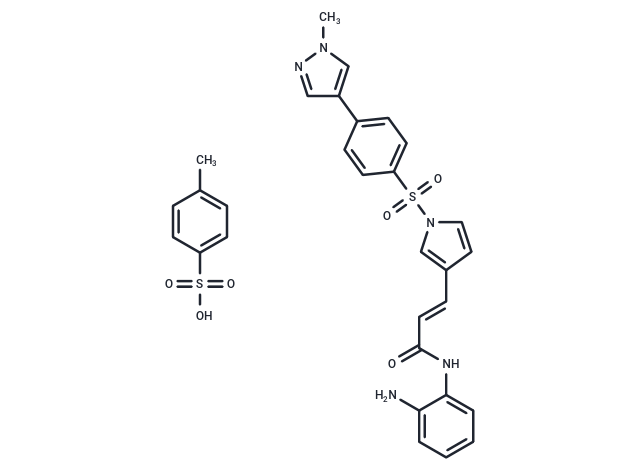Shopping Cart
- Remove All
 Your shopping cart is currently empty
Your shopping cart is currently empty

Domatinostat tosylate (4SC-202) is a selective class I HDAC inhibitor targeting HDAC1/2/3 with IC50 values of 1.20/1.12/0.57 μM, respectively, and also inhibits Lysine-specific demethylase 1 (LSD1).

| Pack Size | Price | Availability | Quantity |
|---|---|---|---|
| 2 mg | $30 | In Stock | |
| 5 mg | $48 | In Stock | |
| 10 mg | $74 | In Stock | |
| 25 mg | $137 | In Stock | |
| 50 mg | $223 | In Stock | |
| 100 mg | $335 | In Stock | |
| 200 mg | $479 | In Stock | |
| 1 mL x 10 mM (in DMSO) | $65 | In Stock |
| Description | Domatinostat tosylate (4SC-202) is a selective class I HDAC inhibitor targeting HDAC1/2/3 with IC50 values of 1.20/1.12/0.57 μM, respectively, and also inhibits Lysine-specific demethylase 1 (LSD1). |
| Targets&IC50 | HDAC2:1.12 μM, HDAC11:9.7 μM, HDAC10:21 μM, HDAC1:1.2 μM, HDAC3:0.57 μM, HDAC5:11.3 μM |
| In vitro | Domatinostat provokes apoptosis activation in CRC cells, while caspase inhibitors (z-VAD-CHO and z-DVED-CHO) significantly alleviate Domatinostat-exerted cytotoxicity in CRC cells. Meanwhile, Domatinostat induces dramatic G2-M arrest in CRC cells. Further studies show that AKT activation might be an important resistance factor of Domatinostat. Domatinostat-induced cytotoxicity is dramatically potentiated with serum starvation, AKT inhibition (by perifosine or MK-2206), or AKT1-shRNA knockdown in CRC cells. On the other hand, exogenous expression of constitutively active AKT1 (CA-AKT1) decreases the sensitivity by Domatinostat in HT-29 cells. Notably, Domatinostat, at a low concentration, enhances oxaliplatin-induced in vitro anti-CRC activity[2]. Domatinostat obviously reduces the proliferation of all epithelial and mesenchymal UC cell lines (IC50: 0.15-0.51 μM), inhibits clonogenic growth and induces caspase activity[1]. Domatinostat treatment induces potent cytotoxic and proliferation-inhibitory activities against established HCC cell lines (HepG2, HepB3, SMMC-7721) and patient-derived primary HCC cells. Domatinostat induces apoptosis signal-regulating kinase 1 (ASK1) activation, causing it translocation to mitochondria and physical association with Cyp-D[3]. |
| In vivo | 4SC-202 (i.g.) inhibits HT-29 xenograft growth in nude mice, and when combined with oxaliplatin, its activity is further strengthened[2]. |
| Alias | 4SC-202 tosylate, 4SC-202 |
| Molecular Weight | 619.71 |
| Formula | C30H29N5O6S2 |
| Cas No. | 1186222-89-8 |
| Storage | Powder: -20°C for 3 years | In solvent: -80°C for 1 year | Shipping with blue ice. | ||||||||||||||||||||||||||||||
| Solubility Information | DMSO: 50 mg/mL (80.68 mM) H2O: Insoluble | ||||||||||||||||||||||||||||||
Solution Preparation Table | |||||||||||||||||||||||||||||||
DMSO
| |||||||||||||||||||||||||||||||

Copyright © 2015-2024 TargetMol Chemicals Inc. All Rights Reserved.